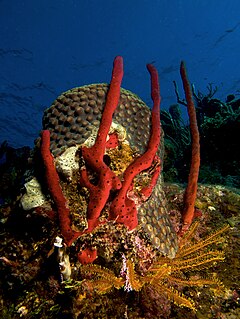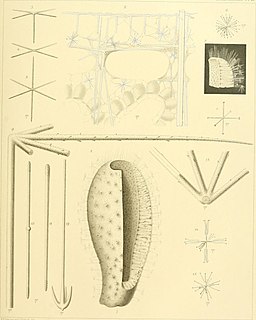In Homer's Odyssey, Amphimedon was the Ithacan son of Melaneus and one of the suitors of Penelope.
Dendyae is a genus of calcareous sponges in the family Dendyidae.

Axinella is a genus of sponges in the family Axinellidae first described in 1862 by Eduard Oscar Schmidt. Species of Axinella occur in the Indian and Pacific Oceans. Most of these sponges are smaller than 20 cm, and have a yellow or orange colour.

Amphimedon queenslandica is a sponge native to the Great Barrier Reef. Its genome has been sequenced. It has been the subject of various studies on the evolution of metazoan development.

Amphimedon is a genus of sponges with over 60 described species. In 2009, Amphimedon queenslandica was the first species of sponge to have its genome sequenced.

Amphimedon compressa, the erect rope sponge, red tree sponge, red tubular sponge, or red sponge is a demosponge found in southern Florida, the Caribbean Sea, and the Bahamas. It can be deep red, orange, brown, or black.
Higginsia is a genus of sea sponges belonging to the order Axinellida.

Niphatidae is a family of demosponges in the order Haplosclerida, first described in 1980 by Rob van Soest. It contains the following genera:
Thrombus is a genus of sea sponge belonging to the family Thrombidae.

Tetractinellida is an order of sea sponges belonging to the Class Demospongiae. First described in 1876, this order received a new description in 2012 and replaced the two orders Astrophorida and Spirophorida, which then became sub-orders as Astrophorina and Spirophorina.

Rossellidae is a family of glass sponges belonging to the order Lyssacinosa. The family has a cosmopolitan distribution and is found at a large range of depths.
Amorphinopsis is a genus of sea sponges belonging to the family Halichondriidae.
Vosmaeropsis is a genus of sponges in the family, Heteropiidae, and was first described in 1893 by Arthur Dendy. The type species by subsequent designation is Vosmaeropsis macera.
Heteropia is a genus of sponges in the family Heteropiidae, and was first described in 1886 by Henry John Carter. The type species by monotypy is Heteropia ramosa, which he first called Aphroceras ramosa in the very same publication.
Holopsamma is a genus of sponges belonging to the family Microcionidae.
Chondropsis is a genus of sponges belonging to the family Chondropsidae.
Amphimedon lamellata is a species of sponge in the family Niphatidae, first described by Jane Fromont in 1993, from a specimen collected at a depth of 9 m, from Macgillivray Reef, Lizard Island in the Great Barrier Reef.
Amphimedon paraviridis is a species of sponge in the family Niphatidae, first described by Jane Fromont in 1993, from a specimen collected at a depth of 7 m, in Geoffrey Bay, Magnetic Island, in the Great Barrier Reef.
Pipestela terpenensis is a species of sponge belonging to the family Axinellidae.




